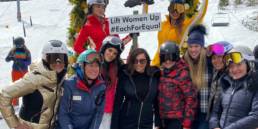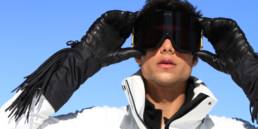Aspen ‘s Highlands is the swanky resort town’s overlooked ski mountain. And that’s a good thing.
Aspen Highlands. The hike up Highland Bowl is responsible for more in-shape Aspenites than Pilates and peer pressure combined. The workout is grueling: a 35-minute trudge up a ridge that rises more than 700 vertical feet to 12,392 feet above sea level. Even the sight is tiring: a steady stream of skiers and snowboarders kicking their toes into a treacherous staircase, labored breath swirling around their helmeted heads. Their goal is the top of the 220-acre diamond, heart-stoppingly steep and possessive of its powder. This is Highlands as it is spoken of, in hushed tones, by those who made the trek and dropped into what may be the best in-bounds skiing in North America.
Highlands has always been the overlooked mountain, the one of Aspen’s celebrated four that doesn’t quite fit. Aspen Mountain is the showcase, obvious on its face but with a thousand hidden lines where powder lies in wait, where every trail leads to a sunny deck and a perfectly respectable Puligny-Montrachet. Snowmass is the family vacation mountain, where kids learn their first turns and mom and dad cruise under the Alpine Springs lift all day — and none of them knows that the cliff band running along the top offers drop-ins as extreme as anything in the West. Even lowly Buttermilk, long relegated to the toddlers and timid, has been reborn as a jibber’s paradise, thanks to a constantly expanding terrain park (including a 22-foot Olympic-size half pipe and, pending Forest Service approval, and Olympic-size ski jump) and a little publicity from ESPN’s X-Games.
Highlands, on the other hand, is the eccentric relative who refuses to dress up for the family reunion. From its founding in 1958 until 1993, the mountain wasn’t even part of the Aspen empire. It was proudly local, with lower ticket prices, unabashedly difficult terrain and a decidedly anti-glam aesthetic that still dominates. But the skiing was always amazing, a legacy of the first mountain manager (Pete Seibert, who went on to found Vail) and the original trail designer (Stein Eriksen, hell, you know who he is). After Aspen Skiing Co. took over, there were lift and grooming upgrades and general improvements in mountain maintenance, but the local feel remained. Rather than fight that, SkiCo wisely played up the mountain’s extreme reputation, gradually bringing more and more of the once dangerous bowl into bounds, with a full opening in 2002, followed by the addition of a lift to haul skiers out in 2005.
The mountain itself is one massive ridgeline, with runs falling off either side before meeting again at the bottom. There is precious little acreage for a base village (which didn’t stop Ritz-Carlton from building a residence club there, or developers from putting up luxury homes), though beer and bluegrass flow freely at the base during après at ZG Grill. But the best runs and the most sun are on the top two-thirds of the mountain, keeping the action up where it ought to be.
Skier’s left of the bowl, and mercifully lift-served, Steeplechase offers steep and deep well into a powder day, the perfect terrain for those who would rather burn their quads riding than hiking. On the opposite side of the ridge, Olympic Bowl offers perfectly spaced trees and shade that keeps the snow from becoming slushy, even on sunny days. Wide, rolling groomers crisscross the mountain, and from top to bottom — hidden behind large orange banners reading “experts only beyond this point” — waterfalls of bumps cascade down narrow chutes. Highlands is best skied with the locals, each of whom seems to have his own mental trail map, complete with secret powder stashes, ephemeral tree runs, and shortcuts, jumps, and rail slides that even the most observant visitor will be unable to see.
Though they are locals, they are still Aspenites, and they have grown used to the finer things. The midmountain restaurant, the utilitarian Merry-Go-Round, is a constantly bustling affair, with fabulous gourmet selections featuring freshly baked bread and local organic meat, plus a roaring fire and an expansive, sun-catching deck. Yes, it is a cafeteria, but it represents the apex of the art. In a converted ski patrol cabin farther up the hill, Cloud Nine — under the direction of chef Andreas Fischbacher — serves Alpine classics in a fine-dining setting at 10,740 feet (970/923-8715, 970/429-3231). Raclette al fresco on a sunny March afternoon may be as close to ski nirvana as you can get while not actually skiing, and the glühwein and schnapps will liven up your final run.
Some say Highlands is Aspen the way it used to be. And while there are countless arguments either way, there is a compromise that needs no defense: Highlands is Aspen the way it ought to be.
SNOW Tidbits:
*The Deep Temerity lift is an extremely steep, fixed triple chair that runs from the bottom of the bowl to the top of Loge Peak, where you can begin the hike again, if you’ve got the legs for it.
*Cloud Nine Alpine Bistro is open for lunch with a daily prix fixe menu, as well as for public snowcat dinners on Thursday nights. 970/923-8715 or 970/429-3231. stayaspensnowmass.com
Related Tags: Destinations, aspen ski, best skiing in the world, ski colorado , ski destinations




